Circa 1860 Gown owned by Caroline (Oswald) Sams (1819-1898)
Introduction & New Video
[Updated April 26, 2023. Bill Riski & Ginny Hall-Apicella]
The Dataw Historic Foundation is fortunate that Sams descendants have entrusted us with several family heirlooms. One such item is a green taffeta silk gown. This gown has been in our possession since 1998, when the owners, Norman Ralph Pippin, Jr., and his sister Pauline Sams (Pippin) Sanders, donated it to us. Twenty years later, we discovered its secrets.
According to Norman and Pauline, the gown belonged to Carrie Lee Lawton (1858-1897), wife of Duncan Sams (1854-1932). They believed she had the dress made in the mid-1880s but were unsure. Carrie and Duncan were married in January 1886. Their youngest daughter Emmie Caroline (Sams) Pippin (1894-1991), was Norman’s and Pauline’s mother. When Emmie passed away in the early 1990s, they began thinking of donating the gown to the “Sams of Dataw.”
We are fortunate they did because, in 2020, this gown revealed its secrets to us. In March 2023, Ginny and I presented in the History and Learning Center on the dress. The one-hour video is below.
Once you hear the whole story, you will realize how lucky we are that this silk dress has survived.
And don’t miss the epilogue at the end of this post about my answer to the question several people have asked me, “Could any of the other children of Caroline O. Sams (i.e., Mrs. M. Brewton Sams) had a role in the pedigree of this dress?”
From Sams to Pippins to Dataw
In 1998, Brenda Norris (Ruins Committee Chair and first DHF President 1995-1998) and her husband Jim drove up to get a gown that had been in the Sams family for 120 years. Norman Ralph Pippin, Jr. and his sister Pauline Sams (Pippin) Sanders donated the items to the DHF.
N. Ralph Pippin and his wife Dorothy told Brenda and Jim in 1998 that the gown (and shawl – see below) were handed down to Duncan and Carrie Sams’ youngest child, Emmie Caroline (Sams) Pippin (1894-1991). She eventually married Norman Ralph Pippin, Sr., in 1925 in Hendersonville, NC. By that time, Emmie’s mother and all her siblings were gone. Emmie and Ralph had two children, Norman Ralph Pippin, Jr., and Pauline Sams (Pippin) Sanders. I discovered from our old paper files that Ralph and his sister visited Dataw Island several times in the 1990s, together and separately. Pauline lived nearby in Bluffton. [Pippin]
In honor of their mother, Ralph and Pauline, GGG Grandchildren of Lewis Reeve & Sarah Sams, donated the dress and a shawl to the DHF.
The shawl has an interesting side story. The prearrangements for the donation were all about the gown. However, a few things changed when Brenda and Jim arrived in Wilmington, NC.
“While there, Pippen’s wife mentioned she also had a shawl. She threw it in a bathtub of water with Efferdent dental(sic) tablets to brighten it. Brenda came back to Dataw with both the dress and shawl.”
[Griffith]
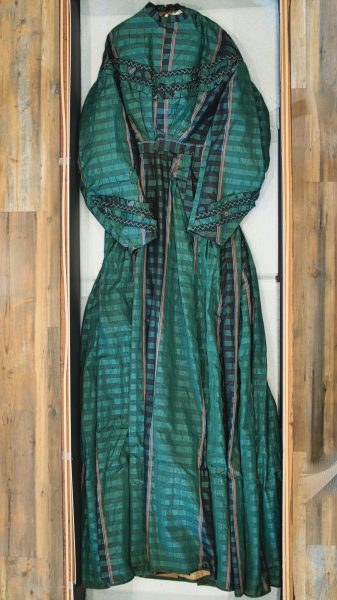
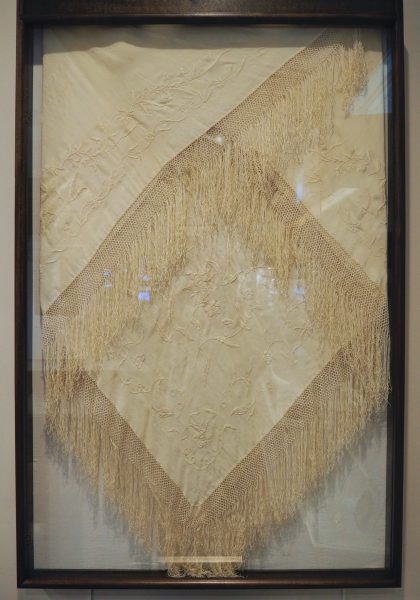
Green Taffeta Silk Gown
The silk gown is typical of the late 19th-century dresses popular in the United States and Europe. Taffeta is a Persian word that means ‘twisted woven.’ This fabric originated in Baghdad sometime in the 12th century. It is one of the most luxurious fabrics, known for its shine, crisp, stiff texture, and smoothness.
Before the Dataw Island History & Learning Center opened in 2016, the gown and shawl were displayed elsewhere on the island. In 2012, the dress was exposed to too much sunlight at its display location in the Dataw Island Club. Fortunately, that is no longer true in the History & Learning Center. The gown is in a display case donated by the Historic Beaufort Foundation when they sold the George Elliott House in the 1990s. The companion shawl is hanging on the southwest wall of the HLC in a new display case made by Peter Pearks in 2020.
Some years ago, there was a concerted effort to contact experts about how best to preserve these fabric items. Taffeta silk is particularly fragile for a surprising reason. In 2012, a Dataw resident, Nancy Hahn, contacted Jan Hiester, Textile Curator of the Charleston Museum. Nancy noted, “Silk of the late 1800s was weighted with metallic salts to give body to the fabric to cause the garment to hang nicely and create the desired rustle when the woman moved. These salt crystals are like shards of sharp and jagged glass embedded in the Silk. What textile historians are seeing now in these antique silk textiles is the resulting damage of the abrasive actions of the salt shards cutting the silk fibers, both during the time the garment was actively worn and in the ensuing years as it was handled, both by well-meaning relatives attempting to preserve it and from curators carefully handling and storing the garment. Almost any type of movement causes the shattering of the silk fibers.” [Hahn]
The Charleston Museum curator liked how our taffeta gown was laid out and protected in the case – with the archival tissue below it and in the bodice, sleeves, and skirt.
In the late 1990s, Ralph Pippin and his sister Pauline Sanders saw the dress in its display case (in another location) and were thrilled. [Pippin] I’m sure they would be so happy to see it today in its current setting in the Dataw Island History & Learning Center.
Much Later, the Gown’s Secrets are Revealed
In February 2020, I wrote about the green silk taffeta dress. Dataw resident Ginny Hall-Apicella shared the article with Kim Poovey, author, storyteller, and Victorian re-enactress. Kim is passionate about 19th Century women’s clothing and the expertise to date items. She looked at the dress photo and said, “That wasn’t sewn in 1880. It’s from much earlier.” So we invited her to examine the gown and help us refresh the preservation setting.
Kim came to our History and Learning Center for a hands-on inspection of the gown. She determined that the dress dates to 1859-1861. She brought reference books that clearly illustrate that the dress has all the classic style elements of the 1860 period: elliptical flared skirt, waistline of the bodice, and coat sleeves. Our gown is also not similar to later periods’ fashions with bustled skirts and long bodices. Upon close inspection, Kim also discovered that the dress had never been worn!
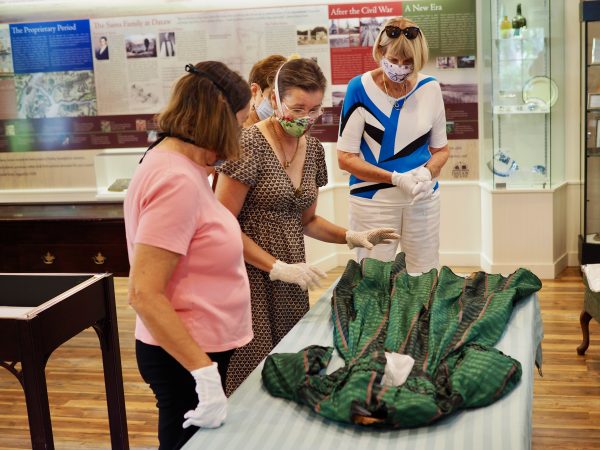
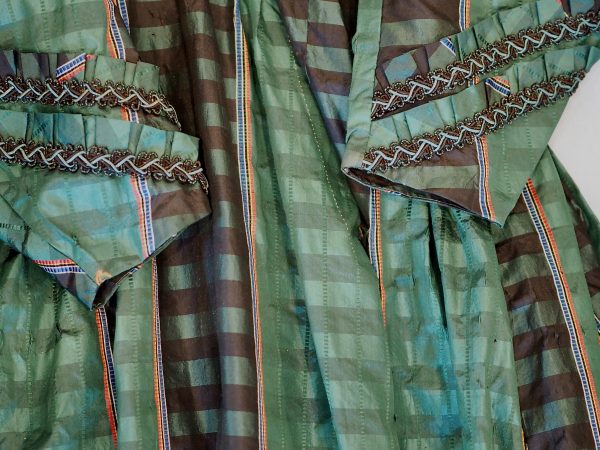
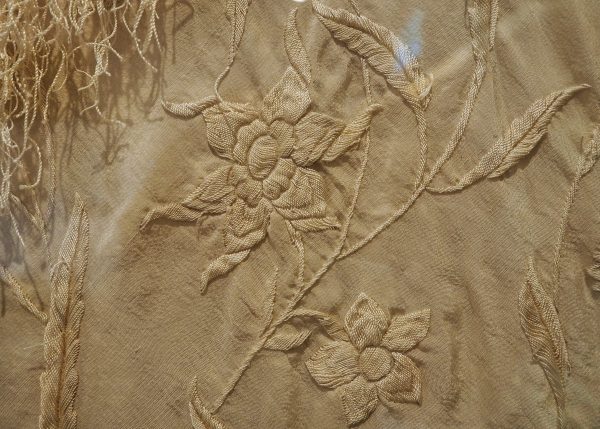
Style, Construction, and Historic Events Tell the Story
First, the dress has no fasteners to hold the bodice front together; there is no evidence that it ever did. Therefore, the dress could not be worn in this state of completion. Second, the dress does not show the perspiration stains expected if the gown had been worn. Third, we don’t know why the dress was incomplete, but we have several clues.
We knew the dress had been in the Duncan and Carrie Sams’s family. First, Duncan Sams is the son of Miles Brewton Sams (1811-1894) and Caroline (Oswald) Sams (1819-1898) of Beaufort and the grandson of Lewis Reeve and Sarah (Fripp) Sams. Second, when we received the gown in 1998, someone left a handwritten note in our DHF files that mentioned Mrs. Miles, Brewton Sams.
Now that we have dated the dress more accurately, it was likely made for Caroline Sams, or someone in the family, in about 1860. She probably grabbed this prized possession in its incomplete state when they fled Beaufort at the outbreak of the Civil War during the Great Skedaddle of November 7, 1861.
Twenty-five years later, Caroline Sams became the mother-in-law to Carrie Lee (Lawton) Sams when Carrie married Duncan Sams (1854-1932). So Carrie may have received this dress from her mother-in-law around her wedding. But that is only one possibility. See the epilogue below for another.
Caroline (Oswald) Sams (1819 – 1898) and Miles Brewton Sams (1811 – 1894)
Duncan Sams is the grandson of Lewis Reeve Sams and his wife, Sarah Fripp. His father and mother were Miles Brewton Sams (1811 – 1894) and Caroline Oswald (1819 – 1898). Duncan was born in November 1854, the time of year when Sea Island cotton planters lived on their plantations. He was born either on Dataw Island or Lady’s Island; his father managed plantations in both locations. Duncan’s parents also built a house in Beaufort, still standing at 801 Prince Street [HBF.]
We have some first-hand information about Miles Brewton Sams from a draft autobiography the DHF recently acquired by Robert Oswald Sams (1841-1930.)
Robert was about 15 years senior to his younger brother Duncan. Per the autobiography, “My father [MB Sams] and his oldest brother Lewis were students at the old South Carolina College, and both graduated from this college. My father graduated after completing the South Carolina Railway connecting Columbia with Charleston. Both my father and Uncle Lewis attended Charleston Medical College. Unfortunately, my father’s health failed, and he had to leave college the year he should have graduated.”
The green gown was made when Caroline was about 40 years old and after the birth of her last and tenth child. The dress was intended for a relatively tall, thin woman. The gown measures about five feet from the collar to the bottom of the hem and is a Misses size 4. Whether this was Caroline or someone else, we don’t know.
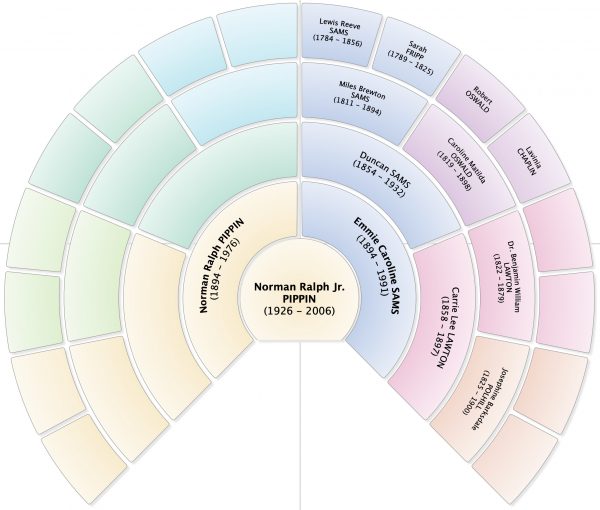
Caroline “Carrie” Lee Lawton (1858 – 1897) and Duncan Sams (1854 – 1932)
Around 1886, the gown came into the possession of Carrie Lee Lawton when she married into the Sams family. Her father and mother, Dr. Benjamin W. Lawton (1822 – 1879) and Josephine Polhill Lawton (1825 – 1900), raised their family in Bullpond, SC. Carrie and Duncan Sams spent their lives together in South Carolina, raising four children. Their oldest child was Benjamin Sams, born in 1887. Next came three daughters, Annie, Pauline, and Emmie. Carrie (Lawton) Sams died in 1897, leaving her husband to raise the four children. Unfortunately, by 1925, only Duncan Sams and his daughter Emmie were still alive. Carrie and three of the four children died before their 40th birthdays. Carrie is buried near her mother, Josephine, in the First Baptist Church Cemetery, Hartsville, SC.
One last historical note about Carrie (Lawton) Sams. Her father, Dr. Benjamin William Lawton, was a very prominent fellow. He was a founding partner in the Savannah River Steamboat Company (1853), signed the South Carolina Ordinance of Secession (Dec 1860), served the Confederacy as an officer in a medical capacity (1862/63), and is buried in the Smyrna Baptist Church Cemetery, Allendale, SC (1879.) [Rowland]
About a decade after Carries’ death, Duncan Sams remarried and lived in Asheville, NC for a while. I wish I had known more about his second wife. She had an unusual name, Lola Moylin Moon. When Duncan died in 1932, his obituary mentioned his close ties to the towns of Gaffney and Allendale, both in South Carolina. He was President of the Gaffney Hardware Company and owned real estate in both areas. His funeral was held at Antioch Church in Allendale, though I have not determined where Duncan Sams is buried.
Epilogue
When Ginny and I did the presentation on the dress in March 2023, I summarized the pedigree of the dress this way.
The green taffeta silk dress and shawl, circa 1860, on display in the Dataw History & Learning Center, originally belonged to Caroline (Oswald) Sams (1819-1898). She passed them down to her daughter-in-law Carrie Lee (Lawton) Sams about 1886. Carrie, or her husband Duncan, handed them down to their youngest child Emmie Caroline (Sams) Pippin (1894-1991), who had them until her death. Emmie left them to her children Norman Ralph Pippin Jr. (1926-2006) and Pauline Sams (Pippin) Sanders (1929-2007). In 1998 Ralph and Pauline donated the dress and shawl to the Dataw Historic Foundation.
During and after the presentation, several asked me if another sibling of Duncan Sams could have played a role. Duncan’s parents, M. Brewton & Caroline O. Sams, had ten children. Four were daughters. One was of the “right” age in 1860; Emma Lavinia Sams (1843-1927). Therefore I dug into the possibilities she presented.
Emma Lavinia Sams (1843-1927)
Emma was coming of age in 1860, at 17 years old. It is possible her mother, Caroline, had the dress made for her daughter. Two facts about Emma intrigued me. First, she lived a long life, and second, she never married. She was fortunate to live long enough to see her younger brother Duncan marry and start a family with Carrie L. Sams. And long enough to see their youngest child, her niece, Emmie Sams Pippin (1894-1991), get married.
Sources
Griffith, Jane – DHF Owns the Dress Case, email dated 8 March 2012
Hahn, Nancy – DHF Victorian Dress on display in Dataw Island Club, memo March 2012
Historic Beaufort Foundation – The Historic Beaufort Foundation Guide to Historic Homes and Places, Tenth Edition, 2014
Hu, Janet – 10 Remedies for Removing Yellow Stains From White Clothes, The GentleManual, accessed 15 Jun 2020
Pippin, N. Ralph – email to Brenda Norris at Dataw Historic Foundation, 28 April 2000
Poovey, Kim – author, storyteller, and living historian. Hands-on inspection of gown and discussions with DHF, 25 June 2020, https://www.kimpoovey.com/
Rowland, Lawrence S., Moore, Alexander, Rogers Jr., George C. – The History of Beaufort County, South Carolina, Volume I, 1514 – 1861
Tabby Times Fall 2020, The Dataw Historic Foundation
Wikipedia – Taffeta, accessed 6 June 2020, https://en.wikipedia.org/wiki/Taffeta
Wikipedia – U.S. Standard Clothing Size, accessed 13 Jun 2020, https://en.wikipedia.org/wiki/U.S._standard_clothing_size
#52Sams Week 24 – Heirlooms


